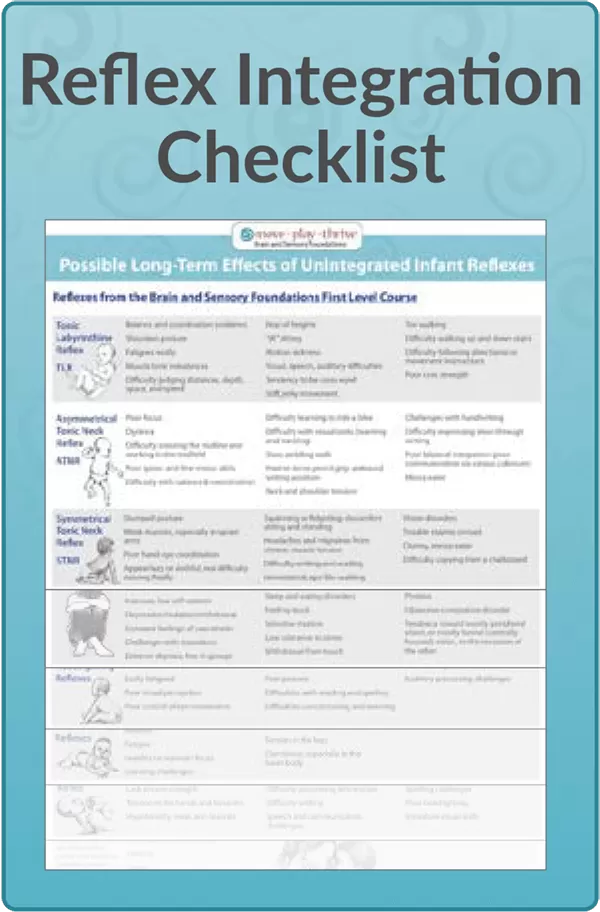Hand Reflexes—Grasp, Palmar, and Babkin
 The Grasp and Palmar/Babkin reflexes have a substantial impact on the functioning of the hands, including the easy acquisition of fine motor skills. Links between the hand reflexes and the mouth have also been shown to affect oral motor function, oral-tactile sensitivity, and speech abilities.
The Grasp and Palmar/Babkin reflexes have a substantial impact on the functioning of the hands, including the easy acquisition of fine motor skills. Links between the hand reflexes and the mouth have also been shown to affect oral motor function, oral-tactile sensitivity, and speech abilities.
Easily observable in newborns, the Grasp reflex is an involuntary curling of the fingers around an object that is placed against the palm. It develops around the end of the first trimester, and is ideally integrated between 4 and 6 months of age. The integration of the Grasp reflex is crucial for proper manual dexterity and pincer grip later in life, since this integration precedes the ability to let go—i.e. open the hand—at will.
Children with perpetually fisted hands generally will have a retained Grasp reflex. Other possible long-term effects include: improper pencil grip, tension in the hands, underdeveloped muscles, or difficulty moving the thumb and fingers independently of each other.
In elderly individuals unintegrated Grasp reflexes were a common predictor of dementia, and researchers asserted that assessing the Grasp reflex should be part of a routine physical examination in the process of diagnosing dementia in the elderly (Altunkalem et al., 2024).
The Palmar/Babkin reflex represents two automatic responses to the same stimulus: the Palmar involves a grasping motion, and the Babkin is a connection between the hands and the mouth. In infancy, Palmar/Babkin is strongly linked to mouth function: for example we often see babies kneading their hands while they suckle. This reflex is designed to support the ability to self-feed by coordinating the hands and mouth with other eating reflexes. It helps the infant to differentiate between the sides of the body, and is vital for the development of articulation.
Researchers determined that the Palmar/Bakin response is clinically useful and that: "Infants exhibiting a marked [Babkin] response at the fourth or fifth month of age and persistence of the reflex beyond the fifth month of age should be carefully observed for the appearance of neurological abnormalities" (Futagi et al., 2013).
Children with speech issues but no hearing impairments often demonstrate a retained Palmar/Babkin. When this reflex is unintegrated, individuals of all ages may exhibit continued hand-mouth connections, such as: sticking the tongue out while engaging in fine motor tasks, movement of the mouth while writing, or moving the fingers while talking.
Integration of the hand reflexes is part of the developmental foundation needed to write with ease and efficiency.
Possible Long-Term Effects of an Unintegrated Grasp Reflex or Palmar/Babkin Reflex:
- Speech delay or difficulties
- Swallowing problems
- Drooling
- Compulsive chewing
- Addictions
- Nail biting
- Hypersensitive palms
- Clenched fists
- Tension in the hands, wrists, and arms
- Manual dexterity challenges
- Poor fine-motor skills
- Poor pencil grip and handwriting difficulties
- TMJ syndrome
- Amphibian Reflex
- Asymmetrical Tonic Neck Reflex
- Birth and Bonding
- Crawling Reflexes
- Crossed Extensor Reflex
- Facial-Oral Reflexes
- Fear Paralysis Reflex
- Feet Reflexes—Plantar & Babkinski
- Foot Tendon Guard
- Hand Reflexes—Grasp, Palmar, and Babkin
- Headrighting Reflexes
- Infant Torticollis
- Landau Reflex
- Moro Reflex
- Parachute Reflex
- Pull-to-Sit Reflex
- Spinal Galant Reflex
- Spinal Perez Reflex
- Symmetrical Tonic Neck Reflex
- Tonic Labyrinthine Reflex
Sources
Altunkalem Seydi, K., Kaya, D., Yavuz, I., Ontan, M. S., Dost, F. S., & Isik, A. T. (2024). Primitive reflexes and dementia in older adults: A meta‐analysis of observational and cohort studies. Psychogeriatrics, 24(3), 688–700.
Futagi, Y., Yanagihara, K., Mogami, Y., Ikeda, T., & Suzuki, Y. (2013). The Babkin reflex in infants: clinical significance and neural mechanism. Pediatric neurology, 49(3), 149-155.
Goddard Blythe, S. (2023). Reflexes, movement, learning & behavior. Analysing and unblocking neuro-motor immaturity. Hawthorn Press.
Masgutova, S. (2007). Integration of infant dynamic and postural reflex patterns: Neuro-sensory-motor and reflex integration method [Training manual].


